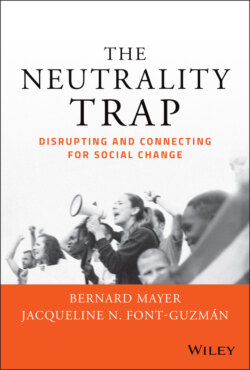Читать книгу The Neutrality Trap - Bernard S. Mayer - Страница 17
Acting Small, Dreaming Big
ОглавлениеBeverly Daniel Tatum (2017, 340–341) argues that the antidote for feeling despair when confronting injustice is to focus our energy on our “sphere of influence.” What and whom can we influence? What are small actions under our control that can lead to fulfilling a dream of a beloved community? How can we expand and strengthen our network? How can we build community? How can we best use our talents? Acting small means using our agency, as limited as it may be at times, to its strategic maximum while keeping our focus on the dream that motivated us in the first place. If we are part of the system, then we can change the system by changing how we behave within the system.
A popular environmental slogan (still seen on many bumper stickers) from about 30 years ago—Think Globally, Act Locally—conveys both a vision and strategy. To understand the scale of the challenge posed by global warming, species extinction, extreme weather, and other environmental disasters, we have to take a global perspective. But how do we promote an effective approach to these challenges? We need a movement with a global vision and a local presence.
For example, how do we combat an economic system that has led to increasing economic inequality? How do we contend with the rise of authoritarian populism? What about nativism, racism, misogyny, imperialism? All of these are global phenomena. The rise of Donald Trump is not disconnected from that of Victor Orban in Hungary, Rodrigo Duterte in the Philippines, or Jair Bolsonaro in Brazil. The global dimensions of these challenges must be understood if movements for change are to flourish. But building effective movements for change requires local action, local leaders, and a focus on local manifestations of global problems. Global networks are important, as are global spokespersons, but the real work takes place in our local communities and organizations where the focus may be affordable housing, police‐community relationships, or sexual misconduct at a local high school.
This is related to a central challenge that mediators are very familiar with: How do you connect the underlying concerns or issues that people are trying to come to grips with in conflict, to the tangible manifestations of them that tend to be foremost in their thoughts and emotions?
Divorced parents may be in conflict over how to share time with their children over Christmas or which school they should attend or where they should spend every other Wednesday night, but these details almost always represent more basic concerns about parenting, decision making, boundaries, and communication.
A neighborhood that is up in arms about plans to locate a homeless shelter nearby may be worried about safety and property values, and there are likely racial biases at work as well. But the focus of discussion instead is usually on parking, traffic, lighting, and design. Almost always, the most strenuous arguments start out about the specifics, but the real problem lies at a deeper or more systemic level. Pretending it is just about traffic and safety can enable racist policies, but ignoring those concerns can prevent genuine engagement from occurring. This challenge is not just about the geographical reach or expression of a conflict. It also involves the systemic versus behavioral view, the immediate concerns versus the long‐term challenge, individual action versus communal responsibility, and the action of groups versus that of leaders. Social movements must find a way to attend to the immediate and local while maintaining a long‐term and far‐reaching focus.
